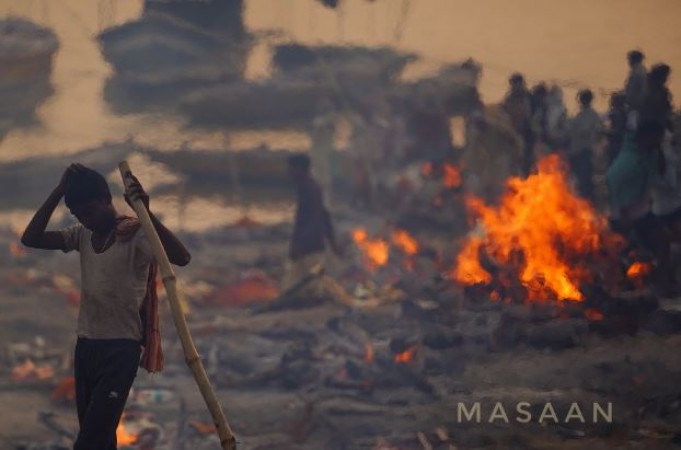
"Masaan," a 2015 Indian drama film directed by Neeraj Ghaywan, won over viewers all over the world with its gripping narrative and stunning visuals. The movie, which took place along the banks of the Ganges River in Varanasi, an ancient city, expertly captured the complexities of life, love, and death. The use of locations, especially the ghats, where much of the story takes place, was one of the movie's most impressive features. Unexpectedly, the ghats used in the filming of "Masaan" weren't the real ghats where these rituals take place, but rather some virgin ghats that had been altered to look like the Varanasi ghats. We will examine the meticulous procedure used to turn these pristine ghats into cinematic marvels in this article.
One of the oldest continuously inhabited cities in the world, Varanasi—also known as Banaras or Kashi—is regarded as the spiritual centre of India. The numerous ghats in the city, particularly those along the Ganges River, are essential to India's religious and cultural life. The backdrop of these ghats is used for a variety of rituals, such as daily prayers, cremations, and pilgrimages. Among these ghats, Dashashwamedh Ghat, Manikarnika Ghat, and Harishchandra Ghat are the most well-known.
The two parallel stories in "Masaan" are each firmly rooted in the customs and rituals connected to Varanasi's ghats. Through the lives of its main characters, the movie examines themes like love, caste, morality, and societal expectations. One narrative tells the tale of Deepak, a young boy from the Dom community who burns corpses at cremation ghats for a living. The other story centres on Devi, a young woman from a higher caste, and her fight for acceptance and redemption in the wake of a tragic event. The ghats are crucial to the story of the movie because they provide the characters' journeys with both a symbolic and literal backdrop.
The process of choosing the filming locations for "Masaan" was essential to giving the narrative an authentic feel. While making sure that it was feasible to film in these revered and busy locations, the filmmakers wanted to capture the essence of Varanasi's ghats. In order to make them resemble the original Varanasi ghats, it was decided to shoot at virgin ghats.
Location Scouting: A thorough location scouting procedure was the first step in converting virgin ghats into Varanasi's holy waters. To find suitable ghats that could be altered to resemble their Varanasi counterparts, the production team searched numerous areas.
Research in Great Detail: After choosing the virgin ghats, the filmmakers started a journey of meticulous research. This involved researching the subtleties of Varanasi's ghats' architecture and culture, including their distinctive patterns, hues, and rituals that were performed there.
Ghat Reconstruction: The production team undertook an extensive reconstruction project to replicate the atmosphere of Varanasi's ghats. They painstakingly planned and constructed sets that mirrored the look and feel of the original ghats. In order to match the distinctive atmosphere of the city, this required creating the recognisable steps leading into the river, the architectural components, and even the precise lighting conditions.
Local Craftsmen and Experts: The transformation process involved the cooperation of neighbourhood craftsmen and professionals who were knowledgeable about Varanasi's traditional craftsmanship and architecture. Their knowledge was essential in accurately recreating the ghats' intricate details.
Authenticity of Rituals: The filmmakers put a lot of emphasis on accurately portraying the rituals and ceremonies that take place on Varanasi's ghats in addition to the physical features of the ghats. Priests and citizens from the area were consulted to make sure that these rituals were depicted accurately and with respect.
Environmental considerations: The filmmakers went to great lengths to reduce the shoot's negative effects on the environment because of the Ganges River's significance to the ecology. Eco-friendly building materials were used to build the sets, and precautions were taken to protect the virgin ghats' cleanliness and beauty.
It took a lot of care, effort, and attention to detail to meticulously transform undeveloped ghats into Varanasi's holy waters. The end result was pure magic in a movie. Audiences and critics alike were moved by the film's stunning visuals and emotionally stirring story.
At the 2015 Cannes Film Festival, "Masaan" won a number of prizes and received a lot of positive critical acclaim, including the FIPRESCI Prize in the Un Certain Regard category. The Varanasi ghats were depicted in the film, which not only enhanced its visual splendour but also provided a metaphorical and symbolic backdrop for the characters' emotional journeys.
Even though the ghats used in the filming of "Masaan" weren't the actual ghats in Varanasi, they were still transformed into works of art that perfectly captured the spirit and essence of this ancient city. The filmmakers took great care to portray the ghats in the film in a respectful and accurate manner by conducting extensive research, paying close attention to detail, and working with local craftspeople and experts. "Masaan" is a testament to the ability of film to envelop viewers in the rich cultural tapestry of India's spiritual core and transport them to far-off locales.
The Remarkable Transformation of 'Dolly Lahore Mein' into 'Happy Bhaag Jayegi'
'Biwi No. 1' as a Remake of 'She-Devil'
Celebrating the Birthday of Mrinalini Sharma: A Bollywood Star's Journey